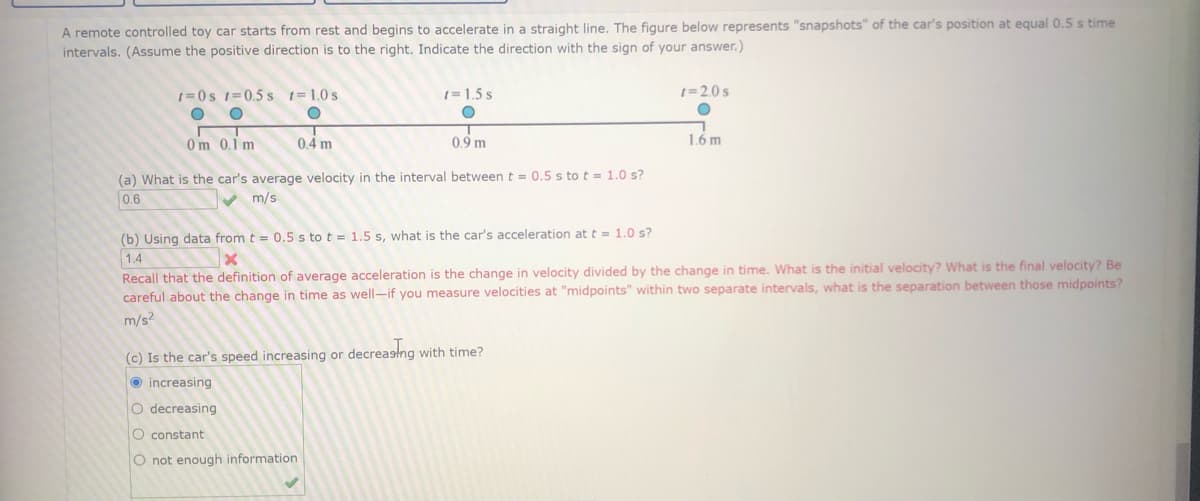A remote controlled toy car starts from rest and begins to accelerate in a straight line. The figure below represents "snapshots" of the car's position at equal 0.5 s time intervals. (Assume the positive direction is to the right. Indicate the direction with the sign of your answer.) 1=0s 1=0.5 s 1= 1.0 s 1= 1.5 s 1=2.0 s 0m 0,1 m 0.4 m 0.9 m 1,6 m (a) What is the car's average velocity in the interval between t = 0,5 s to t= 1.0 s? 0.6 m/s (b) Using data from t = 0.5 s to t = 1.5 s, what is the car's acceleration at t = 1.0 s? 1.4 Recall that the definition of average acceleration is the change in velocity divided by the change in time. What is the initial velocity? What is the final velocity? Be careful about the change in time as well-if you measure velocities at "midpoints" within two separate intervals, what is the separation between those midpoints? m/s? (c) Is the car's speed increasing or decreastng with time? O increasing O decreasing O constant O not enough information
A remote controlled toy car starts from rest and begins to accelerate in a straight line. The figure below represents "snapshots" of the car's position at equal 0.5 s time intervals. (Assume the positive direction is to the right. Indicate the direction with the sign of your answer.) 1=0s 1=0.5 s 1= 1.0 s 1= 1.5 s 1=2.0 s 0m 0,1 m 0.4 m 0.9 m 1,6 m (a) What is the car's average velocity in the interval between t = 0,5 s to t= 1.0 s? 0.6 m/s (b) Using data from t = 0.5 s to t = 1.5 s, what is the car's acceleration at t = 1.0 s? 1.4 Recall that the definition of average acceleration is the change in velocity divided by the change in time. What is the initial velocity? What is the final velocity? Be careful about the change in time as well-if you measure velocities at "midpoints" within two separate intervals, what is the separation between those midpoints? m/s? (c) Is the car's speed increasing or decreastng with time? O increasing O decreasing O constant O not enough information
An Introduction to Physical Science
14th Edition
ISBN:9781305079137
Author:James Shipman, Jerry D. Wilson, Charles A. Higgins, Omar Torres
Publisher:James Shipman, Jerry D. Wilson, Charles A. Higgins, Omar Torres
Chapter2: Motion
Section: Chapter Questions
Problem 14E: A car travels on a straight, level road. (a) Starting from rest, the car is going 44 ft/s (30 mi/h)...
Related questions
Question

Transcribed Image Text:A remote controlled toy car starts from rest and begins to accelerate in a straight line. The figure below represents "snapshots" of the car's position at equal 0.5 s time
intervals. (Assume the positive direction is to the right. Indicate the direction with the sign of your answer.)
t=0s t=0.5 s t=1.0 s
1 = 1.5 s
1= 2,0 s
0m 0.1 m
0.4 m
0.9 m
1,6 m
(a) What is the car's average velocity in the interval between t = 0.5 s to t = 1.0 s?
0.6
m/s
(b) Using data from t = 0,5 s to t = 1.5 s, what is the car's acceleration at t = 1.0 s?
1.4
Recall that the definition of average acceleration is the change in velocity divided by the change in time. What is the initial velocity? What is the final velocity? Be
careful about the change in time as well-if you measure velocities at "midpoints" within two separate intervals, what is the separation between those midpoints?
m/s?
(c) Is the car's speed increasing or decreasing with time?
O increasing
O decreasing
O constant
O not enough information
Expert Solution
This question has been solved!
Explore an expertly crafted, step-by-step solution for a thorough understanding of key concepts.
This is a popular solution!
Trending now
This is a popular solution!
Step by step
Solved in 3 steps with 3 images

Knowledge Booster
Learn more about
Need a deep-dive on the concept behind this application? Look no further. Learn more about this topic, physics and related others by exploring similar questions and additional content below.Recommended textbooks for you

An Introduction to Physical Science
Physics
ISBN:
9781305079137
Author:
James Shipman, Jerry D. Wilson, Charles A. Higgins, Omar Torres
Publisher:
Cengage Learning

College Physics
Physics
ISBN:
9781285737027
Author:
Raymond A. Serway, Chris Vuille
Publisher:
Cengage Learning

College Physics
Physics
ISBN:
9781305952300
Author:
Raymond A. Serway, Chris Vuille
Publisher:
Cengage Learning

An Introduction to Physical Science
Physics
ISBN:
9781305079137
Author:
James Shipman, Jerry D. Wilson, Charles A. Higgins, Omar Torres
Publisher:
Cengage Learning

College Physics
Physics
ISBN:
9781285737027
Author:
Raymond A. Serway, Chris Vuille
Publisher:
Cengage Learning

College Physics
Physics
ISBN:
9781305952300
Author:
Raymond A. Serway, Chris Vuille
Publisher:
Cengage Learning

Principles of Physics: A Calculus-Based Text
Physics
ISBN:
9781133104261
Author:
Raymond A. Serway, John W. Jewett
Publisher:
Cengage Learning